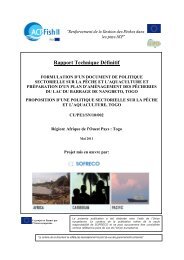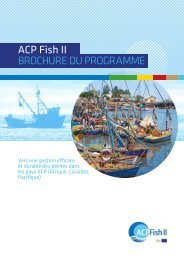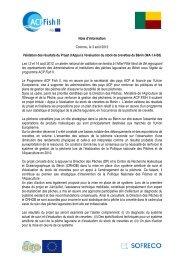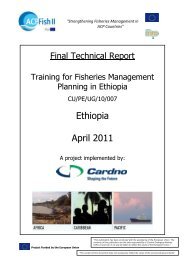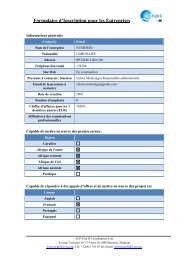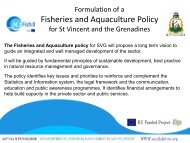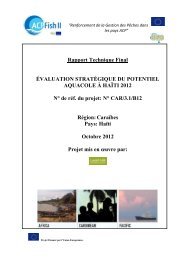Final Technical Report part 3 - ACP Fish II
Final Technical Report part 3 - ACP Fish II
Final Technical Report part 3 - ACP Fish II
You also want an ePaper? Increase the reach of your titles
YUMPU automatically turns print PDFs into web optimized ePapers that Google loves.
Elaboration of an aquaculture development strategy forst. kitts and nevis – Aquaculture situation appraisalFigure 37: Frame or grid mooring using shovel anchors. Expensive design but feasible on deeper sitessaving mooring ropeThe idea of recommending using maximum 30m depths is to make things ‘simple and less risky’and also because of the suggested seasonal model, which will involve some diving activity in thestart and the end of the cage season. The concrete anchors are put on the site ‘once and for all’and each anchor site is registered with GPS. When getting close to the hurricane season thecages are harvested and the nets brought to the shore base/storage. Then the cages aredetached leaving a 3-4 m piece of the mooring rope at the anchor to be used for reinstallation ofthe cages after the hurricane season. The detached cages are towed to a storage area on theshore – the stanchions/uprights and hand rail are dismantled from brackets on the main pipeswhich then can be stocked on top of each other on the beach.In the cages the maximum recommended biomass is up to 15kg/m 3 . The fish most likely can beharvested <strong>part</strong>ially i.e. when there are fish more than 500g (1¼ pound) ready to be sold. Thusactually the production over ‘one season’ may likely be more than 15kg/m 3 .After the hurricane season the mooring from the cages is reinstalled to the anchors which can befound either by their GPS location or by simple trolling with a leaded line between two boats. Themooring ropes are reinstalled to the rope at the anchors by diving.If using cages of maximum 50 to 60m circumference (diameter 16 and 19m) the net bags can stillbe handled manually if not too heavy fouled and if not deeper than 9 m. Larger cages (and netbags) would need the use of hydraulic crane and thus a large vessel to be able to operate.Being a full oceanic environment the cages will need to be protected with predator netting –around the net bags against barracuda and sharks (and possibly others) and a top bird netagainst frigate birds, brown pelicans, gannets, sea gulls, herons and the odd sea eagle orosprey.Due to the low eutrophication level of the tropical oceanic water the environmental impact of thecage farming would likely be very small a<strong>part</strong> from a possible direct impact under a cage. Themost likely impact seen will be stock enhancement around the cages.Of course the cage farming would have to follow Better Management Practises (BMP), but actuallythe SKN aquaculture model already has several of the BMP elements inside it such as:This project is financed by the European Union Project implemented by pg. 71RTF pg. 143/204





